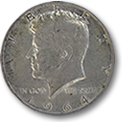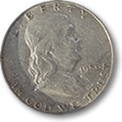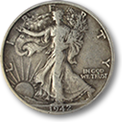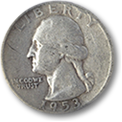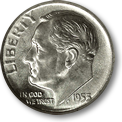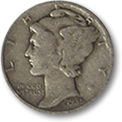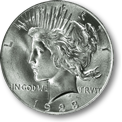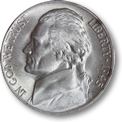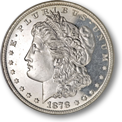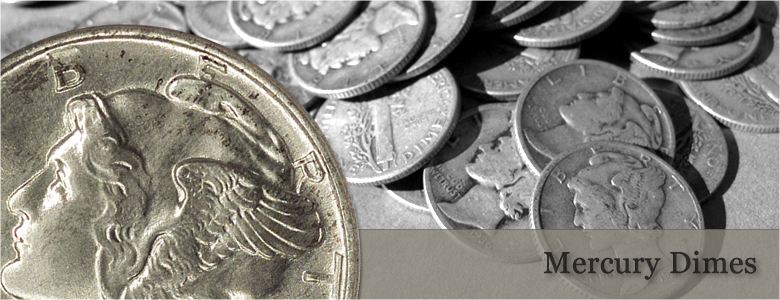
History of the Silver Mercury Dime
Many consider the silver Mercury Dime coin to be the most beautifully crafted of all the dimes coined by the US Mint Department. First issued in 1916, it was not the clearest in meaning or history, however.The Mercury Dime got its name from the wings attached to the crown of Lady Liberty whose image had graced the 90 percent silver US dime since 1796. The addition of the crowning wings to the head of Lady Liberty was to represent freedom of thought. However, the public saw only the crowning wings of the male God, Mercury, and hence its nickname became the common name we use today.
Meaning was important for design in the early years. The fasces in the design hails from the Roman era. In those days it was a custom for any procession of senatorial scale to host "fasces bearers" which were runners carrying bundles of wood boughs through the streets. This symbolic meaning was to communicate strength, although the fact that they were later used to make light for speeches, was also symbolic in combination with the illumination from the strength of the wood boughs they carried. This was, of course immensely useful. At times these silver dimes were called Winged Liberty Head Dimes. This was also the first time the dime used designs that differed from that year's quarter or half dollar.
Beginning in 1915, change was in the wind for US coinage. The gold ten dollar eagle, the gold twenty dollar double eagle, the one cent and the nickel had now received completely new designs and the majority feeling was that it was time to do this to the silver dime, quarter and half dollars. Under the 1890 coinage law, no changes could be made to any coins without first obtaining permission from congress if they were to happen more frequently than once every 25 years. The Barber coins, i.e.; those designed by US Mint Chief Engraver Charles Barber, were the dime, quarter and half dollar. By 1916 the 25 year anniversary would pass and so the US mint began its search for new designs for the dime in 1915.
Current Mint Department Director, Robert Wooley decided to open a competition, which resulted in an offer for the opportunity to make designs to three different designers, for the re-make of three silver coins. The first six coins had been rendered by Charles Barber, the Chief Engraver of the time. Barber was the first engraver, who began his job at the opening of the first US Treasury Department Mintage and had advanced to 75 years old with the reputation of being hostile to outside artists. He viewed mintage coins as "his territory."
Many outside the Mint felt having different American artists designing US coins was a way to honor the independent spirit of the American people. Wooley was nervous that the invitation to three outside artists to re-design Barber's coins would bring down the wrath of Barber onto the artists, making it impossible to work with them to get the engraving completed. History tells us Barber was able to contain himself, perhaps realizing Wooley in his wisdom. At 75, eyes are failing, among other things. Barber stepped aside, and allowed his replacement-in-training, George T. Morgan, designer of the Morgan Dollar, to do all of this related work. It is also possible Barber recognized the beauty in the work, as the designs for these coins were truly remarkable. Regardless of the reasons, Morgan took over the project and in the midst of 1917, Barber died while still in his position, leaving Morgan to become the new Chief Engraver.
Adolf A. Weinmann, Albin Polasek and Herman A. MacNeil were chosen to prepare designs for three silver coins. Adolf Weinmann won the award of two coins for his designs. He became known for his creation of the Walking Liberty, which strides across many silver Half Dollars today. The other, was for his Winged Lady Liberty, created for the new dime. Mac Neil's design landed on the quarter. Polasek, was dropped from the design group altogether. Weinman was an immigrant from Germany, coming to the US at the age of 10, in the year 1880. His teacher was well-known sculptor Augustus Saint-Gaudens. Saint-Gaudens is credited with some remarkable coin designs as well. By 1915, at the beginning of this design competition, Weinmann was commonly seen as our nation's most talented and celebrated sculptor.
The winged liberty design is based on a bust created in 1913 by Weinmann of Elise Kachel Stevens. Poet, Wallace Stevens, and his wife Elise were tenants in the apartment building owned by Weinmann. On its reverse, the coin displays the fasces, symbolizing authority moving forward with time. There is a battle-axe above, symbolizing preparedness. An olive branch image was intended to invoke love and peace through authority. There was a delay with the dies needed to strike the coins, so they were not released until later in the year. Once the dies were completed, production began in both Philadelphia and San Francisco where they made millions of them during 1916. Coinage need was high in these days, and so silver Barber dimes were also minted that year. Denver, however, had stopped production of Barber dimes in 1914. Denver minted a sparse 264,000 of the new dimes, which caused the 1916-D Mercury Dime to be considered rare, instantly.
Not long after it was released into circulation, the public began calling it the "Mercury Dime." The hat was modeled after the Petasus, a cap that messengers wore for identification while running. Mercury, the Roman God of trade, was awarded wings for his Petasus, so he could serve the Gods better, at higher delivery speeds. The Romans heralded Mercury as the God of trade, property and wealth, making this a fitting symbolism. This design remained in circulation until 1945, when the death of Franklin D. Roosevelt sparked a public desire to honor and immortalize this well-loved leader. We are still using the Roosevelt dime today. However, the dimes were only 90 percent silver until 1964. Today, they are termed junk silver coins. From 1965 onward, the silver content was removed.
The Mercury Dime is still very popular today. Sought by both beginners and experts, the Mercury Dime complete sets that include the keys, can be sold for as much as $1500. The keys in these sets will be in bad condition, however. The nicer sets that are graded at least G4 with good quality keys included can cost over $2000. To avoid the cost of a year-set collection avoid the expensive 1916-D. The 1921 dimes can go for $50 or more. Both mints, P or D are considered keys. San Francisco didn't produce any that year. Other dates are much easier to locate. The Mercury short-set consist of all years and mints from 1934 up to 1945. Also; 1941 to 1945. These short sets can be attractive and inspiring.
If a set doesn't include the keys, all the dates and mints can be found and purchased for fewer than ten bucks over their silver value in G4 condition, the majority go for about $3 over their silver value. Most dimes released after 1940 are found in decent grades going for about their value in silver, and are called junk silver by silver dealers and precious metal traders. Philadelphia released more of them into circulation by far producing 65.9% with Denver striking 17.8% and San Francisco trailing at 16.3%.
The totals for production only exceeded 50 million six times. Numbers almost exceeded 67 million in 1939. Production far outreached the Barber Dime however they pale in comparison to the final minting of its last years. 1941 brought 175 million dimes into the market, while in the last four years production never dropped under 159 million. A total of 2.6 billion were released into circulation and 56% of them came out in the last five years, in part coinciding with WWII. The low release numbers was caused by the depression, where reduced coinage was the result of reduced income and spending.
Grading criteria for these coins can change with the Mint State varieties. Fully struck coins have what are known as Full Split Bands, or FSB. It refers to the fasces that host clearly defined horizontal bands with clear separation between them. These are premium Mint State coins that can demand premium prices.
Although it is not the rarest, the Mercury Dime is definitely the most popular dime in US history. The Roosevelt Dime is still seen as a bit boring, while the dynamics of the winged liberty design can clearly be seen as value-added. The 1916-D remains the most difficult to locate and expensive to buy. The early year issues were hoarded by collectors which served to preserve them as well. Initially the 1916-D was not aggressively pursued because it took a while for collectors to realize how light the strike run had been.
This is apparent when visibly inspecting this run—the majority of them were circulated for years, showing the intensity of wear. The dimes found in the "New York Subway Hoard", as it came to be called, did not begin this hoarding until 1940, when the low numbers and rare D mintmark became well advertised. After more than 25 years from first circulation only 251 1916-D's were in the collection.
Lowest grades for these dimes are FA2 and G3, which cost up to $500. The VG8 runs about $1300, and is actually commonly available. The second key—the 1921-D was released just before the 1921-P, both mintages generating over a million coins. Both varieties cost over $50 at the G/VG grade.
Individual coin prices drop from here when the next semi-key coins are the 1926-S and 1931-D. They both sell for less than ten bucks at the lower grade level. The lower grade coins do have rare dates; however, they are not very attractive to the eye. These coins show only partial dates and mints. It is difficult at best to decipher any details whatsoever. The prime coinage available for these beauties can cost up to tens of thousands of dollars. The 1945-P is available in every grade, FSB varieties are very rare. Common dates from 1940 on have scores graded at MS-67 while the 1945-P only has three certified PCGS coins certified.
Errors make coins more valuable. The most famous error for the Mercury Dime occurred in 1942, when the coin was over-dated or re-stamped onto the 1941. This happened both in Denver and in Philadelphia causing the popularity of these anomalies to compete with the 1916-D. In their lowest grade, they go for at least $500, even though it is very difficult to identify the error. Because of this reality, most dealers recommend using a very trustworthy coin appraiser for the identification. The other approach is to stay with only certified versions. Another anomaly happened in 1945 when a size change occurred on the San Francisco mintmark. Today they are known as the "micro S" series and sell for a premium over the regular "S" series.
Because of the design impressiveness, the Mercury Dime proofs are exquisite. Only produced for seven years, a complete proof set in PR-65 condition goes for about $5000. Those who choose to collect the historic coins of our nation become part of the long history of American currency, financial development, artistic expression and political will.
Today, the mercury dime is most valued as a hedge against inflation because of its intrinsic silver content. These junk silver dimes are commonly traded as silver bullion, usually slightly below their silver value.








